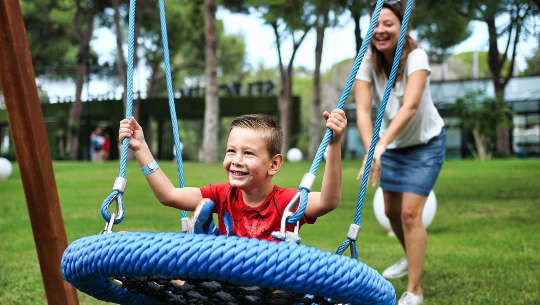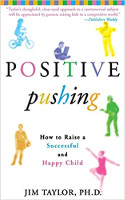
Image from Pixabay
What do kids really need to be successful and happy people? Parents, educators, and society as a whole couldn't ask a more important question. How you answer this question will determine how you will raise your child, what lessons your child will learn, what values he will adopt, and, ultimately, what kind of adult he will become.
The question of what kids really need to become successful and happy people has been asked since the Enlightenment. The answers have been many and diverse, ranging from "spare the rod, spoil the child" to "let them find their own way."
As with such issues, the answer to this question likely lies somewhere between those two extremes. People have a tendency to oversimplify these matters because it makes a complex issue easier to deal with. But it also probably makes the answer inadequate.
WHAT DO KIDS REALLY NEED?
My answer to this question reflects back on what parents did well and where they may have erred during the past fifty years of child rearing. It also looks at the present to understand what is unique about our society during this period in our history that makes child rearing such a challenge. And my answer attempts to gaze into the future to better understand our society and where child rearing may be going.
My response to the question "What do kids really need?" is a two-part answer. The first part of my answer focuses on the "what" of the question, namely, the essential qualities that every child needs to become a successful and happy adult. The second part of my answer addresses the "how" of the question, specifically, how you can help your child to develop those qualities. Ultimately, my answer is intended to empower you to act on your values and beliefs, and to become a positive, active, and purposeful force in your child's life.
THREE PILLARS OF SUCCESSFUL ACHIEVERS
Parents who want their children to achieve something called "success" may find that this goal conflicts with their desire for their children to also become happy. Achieving success, as frequently defined by our society, emphasizes wealth and social status and is often at odds with experiencing satisfaction, contentment, and happiness.
A perusal of the psychology section of any bookstore shows that the goal of achieving success by itself is inadequate. As Dr. Jack Wetter, a Los Angeles clinical psychologist, observes,
On the one side, you've got books on how to raise achieving, successful children. And across from that, you've got books for adults on how to overcome your depression and increase your self-esteem.
The purpose — and the theme — of Positive Pushing is to guide you in raising your child to be a successful achiever. Successful achievers are distinguished from those who simply achieve success in that, for successful achievers, success and happiness are synonymous. Not only do they not view success and happiness as mutually exclusive, parents of successful achievers see them as necessarily mutually inclusive. Success without happiness is not success at all.
Implicit in the notion of successful achievers is that a necessary part of success and happiness is the internalization by children of universally held values such as respect, consideration, kindness, generosity, fairness, altruism, integrity, honesty, interdependence, and compassion. Children cannot become successful achievers unless they adopt and live by these essential life-enriching values.
The development of successful achievers comes from fostering the Three Pillars of Successful Achievers: self-esteem, ownership, and emotional mastery. These three areas provide the foundation for raising children who are successful, happy, and possess life-affirming values. The goal of Positive Pushing is to show you how to raise your child with these three pillars so that his or her childhood development will lead to a life of success and happiness.
FIRST PILLAR: SELF-ESTEEM
Self-esteem has been perhaps the most misunderstood and poorly used developmental area in recent generations. In the last few decades, parents were led to believe that self-esteem developed if a child felt loved and valued. This belief caused parents to shower their children with love, encouragement, and support regardless of what their children actually did.
Yet this "unconditional love" is only one half of the self-esteem equation. The second part is that children need to develop a sense of competence and mastery over their world. Most basically, children must learn that their actions matter, that their actions have consequences. Since the 1970s, parents have often neglected to provide their children with this essential component of self-esteem.
Your child will develop high self-esteem from receiving appropriate love, encouragement, and support, but also from the sense of competence he develops from opportunities you give him to learn and use skills in the pursuit of achievement. High self-esteem also acts as the foundation for the other two pillars that form the essence of successful achievers.
SECOND PILLAR: OWNERSHIP
Another mistake that parents can make in trying to develop high self-esteem in their children is to provide them with too much love, encouragement, and support. By investing so much of their own self-esteem in their child's efforts, parents, in effect, assume ownership of their child's achievements. Though these efforts are often well-intentioned, the result is that children feel no sense of connectedness and responsibility for their efforts. The children end up being unable to say, "I'm doing this because I want to."
Children need to gain a sense of ownership of their life's interests, efforts, and achievements. This ownership means that they engage in an activity out of an enduring love for it and an internally derived determination to do their very best. This ownership also provides them with an immense source of gratification and joy from their efforts that further motivates them to strive higher in their achievement activities.
THIRD PILLAR: EMOTIONAL MASTERY
The third pillar of successful achievers, emotional mastery, is perhaps the most neglected aspect of a child's development. Parents have been led to believe that letting their children experience negative emotions such as frustration, anger, and sadness will harm them. Based on this belief, parents have felt the need to protect their children from feeling bad. They rationalize failure, distract children from experiencing emotions deeply, try to placate negative emotions, and create artificial positive emotions.
Yet, parents who protect their children from their emotions are actually interfering with their children's emotional growth. These children end up never learning how to deal effectively with their emotions and enter adulthood ill-equipped for its emotional demands. Only by being allowed to experience emotions are children able to figure out what emotions they are feeling, what the emotions mean to them, and how they can manage them effectively.
This third pillar explains that you will want to give your child opportunities to experience emotions fully — both positive and negative — and provide her with guidance to understand and gain mastery over her emotional life. Children who do not develop emotionally can still achieve success, but the price they pay is often discontentment and unhappiness in their successes. Emotional mastery enables children to not only become successful, but also to find satisfaction and joy in their efforts.
WHY CHILDREN NEED TO BE PUSHED
Many children are creatures of inertia (as are many adults). They will remain in their current state — for example, lying on the couch all day watching TV — unless you exert a force on them. If you do not push your child, she will be greatly hindered in her learning to walk and talk. She will not want to work very hard or strive to do very much. At best, without pushing, she will do things more slowly or less well than she is capable.
Children do not like discomfort. When they first try something new, they will often put forth effort until it gets difficult or uncomfortable. Then they will look to others — most often to you— to see whether they have gone far enough. If you say, "Great job. You can stop if you want," they often will. By stopping, your child will never find out what he is capable of and will miss out on the satisfaction of moving out of his comfort zone and pushing his limits.
If you push him to try harder and persist longer, "Good job so far, but we bet you can do even better," he is more likely to face his discomfort and attain a higher level of achievement and satisfaction. As Boston Globe writer John Powers observes, "A funny thing happens when you raise the bar. People find a way to get over it, once they realize it's expected. Human beings can do amazing things — if they're asked to."
FLY, BABY, FLY
A powerful metaphor is that of the mother bird and the baby bird in the nest. The time has arrived for the baby bird to learn to fly. But the baby doesn't know it. If left to its own devices, it might remain in the warmth, comfort, and safety of the nest forever. The mother knows the time has come for the baby bird to leave the nest. The mother knows that any earlier the baby would have been unprepared to fly and might have fallen to the ground. And the mother knows that any later and the baby would resist leaving the nest. So, with a firm nudge, the mother bird pushes the baby bird out of the nest, having complete faith her baby is ready. And the baby bird does fly!
The best way to illustrate why pushing your child is so essential is to describe the qualities that make successful achievers both successful and happy. Successful achievers have ingrained essential values that enable them to be productive, caring, and thoughtful people. These values, in turn, allow them to take risks and to explore, test, and realize their fullest abilities.
These experiences teach successful achievers about the connection between their efforts and their results, and strengthen their sense of control over their lives. In the course of their efforts, successful achievers experience both success and failure, and learn the valuable lessons of each. These experiences provide them with great satisfaction and fulfillment in giving their best effort, regardless of whether they succeed or fail. The culmination of this process results in successful achievers understanding what makes them happiest, helps them to find their life's passion, and impels them to pursue their dreams to their fullest extent.
If you don't push your child, she will have a much more difficult time developing these essential elements of becoming a successful achiever. Some people have described pushing children as a form of child abuse (and it can be), but not pushing your child may be a form of neglect that can be equally destructive. Like the mother bird with her baby bird, you need to be willing to push your child so that she will learn to fly and to soar to her greatest heights.
WHY PUSHING HAS GOTTEN A BAD RAP
The popular view of pushing holds that parents need to force their children to do things that they do not want to do, like cleaning their rooms, doing their homework, or practicing on the piano. Today's parents have been told that pushing will make their children angry and resentful, reduce their desire to achieve, and leave permanent emotional scars that will handicap them for life. There appears to be some truth to that notion of pushing. The University of Massachusetts researchers Ena and Ronald Nuttall found that parents who pushed too hard, in the form of rigid and angry control, actually reduced their children's motivation to achieve. Unfortunately, misunderstanding of research of this type and some parents' own experiences have led many to back away from pushing their children altogether rather than to learn how to push in a healthy and appropriate way.
Many baby boomers apparently have unhappy memories of their upbringings. I often hear parents say something like: "I don't want to raise my child the way my parents raised me." When I ask these parents about their childhoods, they describe their own upbringings as "oppressive, cold, restrictive, or controlling." Drs. Don Dinkmeyer and Gary D. McKay, the authors of Raising a Responsible Child, observe that "our autocratic tradition, emphasizing punishment and reward, has trained us to prod and nag rather than encourage. Often our language merely echoes the comments our own parents made to us."
What the above research and this quote tell us is that pushing is destructive when it is negative, angry, controlling, and demeaning. This type of pushing causes children to feel threatened. Children are inherently motivated to avoid threats and will, if threatened, avoid trying to achieve anything. Because many parents seem to have been raised with this negative kind of pushing, they fear pushing in general to be something that will hurt their children. Because of this negative view of pushing, many parents aren't able to see that the problem is how they push, not whether they push.
This is a great loss to their children. As Ena and Ronald Nuttall have found, parents who are more accepting and encouraging, and less hostile, raise children who are hardworking, competent, and ambitious. Positive pushing works.
This current generation of parents seems to be reflecting on how they were raised and then choosing to raise their own children in a very different manner. Unfortunately, to correct the perceived mistakes of their parents' child-rearing methods, many new parents are going to the opposite end of the child-rearing spectrum, using a laissez-faire approach that offers children little direction in all aspects of their lives. The University of Georgia researchers Rex Forehand and Britton Mc-Kinney traced the disciplinary practices of parents over the past forty years and found four primary trends that have fostered this overreaction and resistance to pushing: (1) a shift from strict to lax discipline that gives children mixed messages, (2) guidance on discipline moving from Puritan religious beliefs to "experts" in fields such as psychology, (3) legislative changes aimed at strengthening children's rights, and (4) a diminished role of fathers in child rearing and discipline.
It seems clear that many parents of the last generation pushed too hard, too unrelentingly and inappropriately, and many children suffered because of it. You might be one of them. The current dominant child-rearing philosophy appears to be a well-intentioned reaction to correct these mistakes. Unfortunately, this overreaction has taken away from parents an essential parenting tool.
PUSHING IS A MORAL IMPERATIVE
I believe that you should push your child. Not only is it okay, it is your right, responsibility, and your absolute moral imperative as a parent. I am going to attempt to show you why you need to push your child. I will describe what I consider to be the dangers of not pushing your child. And I am going to try to show you how to push your child so that, instead of the very real possibility of your contributing to the raising of an unhappy and unproductive person, your child will have a much greater opportunity to become a successful achiever.
I hope to change the way you think about pushing your child by broadening the definition of what pushing means and describing the right and wrong ways to push. I am going to give you permission to do what you have wanted to do for a very long time, but were too afraid to do — push your child to become the most successful and happiest person she can be.
THE POWER OF POSITIVE PUSHING
Positive pushing is aimed at motivating your child to action. It encourages growth in your child. Positive pushing impels your child to move out of her comfort zone, to explore, and to take risks. It fosters achievement and success. So far, positive pushing may not seem much different from pushing as you know it. What separates positive pushing from old-style pushing is that, as the term would suggest, it is positive and encouraging. Positive pushing always demonstrates the love, respect, and value you hold for your child. Positive pushing allows your child to feel in control of her achievement efforts. It is also flexible and responsive to your child's needs. By the very nature of positive pushing, your child sees that your pushing is intended to be in her best interests.
Positive pushing involves exerting a powerful influence over the values, beliefs, and attitudes you want your child to internalize. There are three ways you can "push" your child.
First, you influence your child through modeling, in which your child observes your emotional expressions, problem-solving strategies, and coping behaviors. Positive pushing involves "walking the walk" on your beliefs, attitudes, and values. "Do as I say, not as I do" just doesn't cut it with positive pushing. You need to live and act on what you believe.
Second, you teach or coach your child, providing direct information, instruction, and guidance on values, beliefs, and behavior. It includes talking to your child about what you value in life and sharing your perspectives on life, family, career, and other areas.
Third, you manage your child's environment and activities — peer interactions, achievement activities, cultural experiences, leisure pursuits — in ways that reflect the values, attitudes, and behaviors that you want your child to adopt. Positive pushing means actively creating an environment at home, in school, and in your community that will foster success and happiness.
Positive pushing emphasizes creating options for children from which they can choose a direction, and stressing that doing nothing is not an option. It requires that children try different things before they make judgments about them. Positive pushing demands that you push your children to go beyond what they believe are their limits. Encouraging your children, providing emotional, practical, financial, and other types of support, offering guidance and feedback, and giving them love and attention are also forms of positive pushing.
Yes, positive pushing also means occasionally strongly directing your child to do things he doesn't want to do. You will be able to push your child in this way because you believe it is in his best interest. You should hold your child to certain expectations that reflect your values and beliefs, for example, sustained effort, responsibility, consideration, and cooperation. These values will be reflected in schoolwork, household chores, and helping others. Only by requiring your child to adhere to these values will he be exposed to them, learn them, and, eventually, internalize them. Moreover, if your child is actually engaged in activities that employ the values that you deem important, he is more likely to adopt them as his own.
This kind of positive pushing is especially important in helping your child to learn to make informed decisions. Too often, a child makes a decision about something that might be of benefit to her without having tried it. Perhaps she has some preconceived notions about it, has heard about it from friends, or it just doesn't seem particularly appealing at face value. In these situations, you should strongly encourage — push — your child to actually experience it, whatever the "it" is, so that she can make an informed decision about its value and interest, and whether to continue the activity.
This is particularly important because most things of value in life cause some discomfort when they are first experienced. For example, the monotony of homework, the repetition of practicing a musical instrument, or the physical demands of learning a sport can all be initially discouraging. If your child is allowed to stop before she has reached a point where she can experience some of the rewards of an activity, she will miss out on two essentials of life. Your child will not learn the value of commitment to achieving success and happiness, and she will not experience the satisfaction and pure joy of achievement.
THE PURPOSE OF POSITIVE PUSHING
What do you value in raising your child? What is important to you in his development and his progress toward adulthood? What qualities do you want to instill in him? Do you want him to be achieving or happy, driven or content, successful or satisfied, or all of these? These are fundamental questions that you need to ask yourself when your child is young. The answers to these questions will have a profound impact on which path your child chooses and what kind of person your child becomes.
The answers you find to these questions reflect your view of the meaning of life and the values that you derive from this perspective. How you value family, faith, education, social justice, health, achievement, happiness, and lifestyle will influence how you raise your child. Whether you do so consciously or not, you communicate your values to your child through the life you lead and the choices you make. As Calvin Trillin, the author of Messages from My Father, observes, "It seems to me that upbringings have themes. The parents set the theme, either explicitly or implicitly, and the children pick it up, sometimes accurately and sometimes not so accurately." Positive pushing is how you can forward your theme. It is the way you deliberately choose, communicate, and instill those values and perspectives in your child.
THE ART OF POSITIVE PUSHING
Positive pushing is not an exact science in which clear rules can be given to you about how and when to push your child. Rather, positive pushing is an art that takes thought, sensitivity, and experimentation to find out the type and intensity of pushing that will be most effective with your particular child. Some parents push their child relentlessly without considering the impact that this oppressive force has on him. Other parents give their child complete free rein to do whatever he wants with no accounting for how this unrestricted freedom affects him. The art of positive pushing involves finding a healthy balance between these two extremes.
The art of positive pushing requires that you temper your expectations of success with love of your child. Everything you do with your child is an expression of the degree of control (pushing) and acceptance (love) you express. Parents who are low in control and low in acceptance produce children who are the most troubled because they receive little from their parents in terms of love or boundaries. These children tend to be unhappy, undisciplined, unfocused, and emotionally immature. Parents who are low in control and high in acceptance raise children who are spoiled, impulsive, irresponsible, and dependent. Parents who are high in control and low in acceptance have children with low self-esteem who are socially unskilled, feel unloved, and are angry at and resentful of their parents.
The ideal combination of these attributes is parents who are high in both control and acceptance. The children who have had the benefit of this kind of parenting tend to have high self-esteem, are emotionally mature, and are high achievers. As Dr. Mary Pipher, the author of Reviving Ophelia, suggests, these latter parents find "a balance between security and freedom, conformity to family values and autonomy . . . protection and challenges . . . affection and structure. [Children] hear the message `I love you, but I have expectations.' In these homes, parents set firm guidelines and communicate high hopes."
The art of positive pushing involves learning when you are pushing too hard. Pushing too hard can produce short-term results seen as improved effort and greater achievement. Children who are less mature or less able to express their feelings toward their parents will, for a time, respond to their parents' unrelenting pushing out of fear of loss of their parents' love with strong effort and high achievement. These initial benefits can mislead parents into believing that their forceful pushing works. But excessive pushing will always come back to haunt both parents and their children. Though these children may be high achievers for some time, they will also be very unhappy because of the tremendous pressure they feel from their parents. At some point, these children will reach a level of maturity or the burden from their parents will become so great that they will push back in some destructive way to relieve the pressure. What results are children who are both unsuccessful and unhappy.
Children often have difficulty telling their parents directly that they are pushing too hard for fear that their parents will be disappointed in them. Instead, children communicate to their parents that they are feeling too much pressure initially in subtle — and often unclear — ways, such as not trying as hard, breaking or losing equipment or materials, or sabotaging their achievement efforts. Unfortunately, parents misinterpret this behavior as a lack of motivation and appreciation. Rather than considering what message their children are trying to convey, parents often have a knee-jerk reaction of anger and assume a "How ungrateful after all I have done for you" attitude that further increases the pressure on their children. These conflicting reactions produce a vicious cycle of anger and resistance, and a destructive tug-of-war for control over the child's life. If this battle of wills continues, children may communicate their messages more "loudly" by using more destructive "language," such as overt rebellion, disruptive behavior, or substance abuse.
Children have a great ability to communicate to their parents that they are being pushed too hard. Unfortunately, they often speak to their parents in a language in which their parents are not fluent. The art of positive pushing means being sensitive to how your child is responding to your pushing. An essential part of sensitivity is learning to speak your child's language. This understanding also involves deliberately considering the message your child is trying to communicate — which often your child doesn't even know consciously — and responding in a way that conveys to your child that you hear what she is saying. By learning your child's language, you can accurately interpret her messages and act in her best interests.
Two forces are required to engage in a pushing match. If you push too hard, your child will push back harder to resist the force. If you ease your pressure, your child will also let up. What parents often don't realize is that sometimes less is more — if you back off from pushing, it allows your child to continue in the direction he (and you) want to go. By backing off, you increase the likelihood that your child will regain his motivation, return to his high level of achievement, and actually have fun again in the achievement activity.
As John Grey, Ph.D., the author of Children Are from Heaven, observes, "When children resist a parent, it is often because they are wanting something else and they assume that if you just understood, you would want to support their want, wish, or need. . . . The power of understanding your children's resistance is that it immediately minimizes resistance. When children get the message that you understand what they want and how important it is to them, then their resistance level changes."
POSITIVE PUSHING MEANS PUSHING YOURSELF
Positive pushing doesn't just refer to your doing or not doing things to your child. In order to push your child appropriately, you must first push yourself. In my years of work with young achievers, I have come across no truly mean or ill-intentioned parents. I meet parents who are often misguided, sometimes confused, and occasionally disturbed. Mostly, though, I find parents who love their children and want the best for them, but either they don't know what is best for them or they carry so much emotional "baggage" from their own upbringings that they aren't able to act on what is best for their children. I have found that when most parents are guided to understand what is in their children's best interests, parents will try to do whatever they can to provide what is best for them.
Whether a child becomes successful and happy does not necessarily depend on how "good" or "bad" you are as a parent or what kinds of mistakes you make in raising your child. Rather, how your child ultimately turns out depends on your openness to doing things or making changes that are in the best interests of your child. If you are willing to do what is best for your child — which may include making changes yourself and supporting change in your child — the possibilities for your child's future are good. If you are not willing or able to do what is best for your child or you can't change yourself or foster change in your child, your child will have a lesser likelihood of a richly developed adulthood.
I have come across two types of problem parents in my work with young achievers. The most difficult parent is one who is unwilling or incapable of acting in his child's best interests or making changes that will help his child. This parent is so rigid in his belief that he is doing the right thing or he carries so much emotional baggage that he simply lacks the capacity to respond to his child's needs or to make necessary changes in himself. This parent is unable to consider that he has made mistakes in raising his child and is threatened by the suggestion that he must change in order to help his child. If this child is left to deal with her unsupportive parent on her own, her chances of becoming a successful achiever are slim. If this child is fortunate enough to receive support from, for example, her other parent, a psychotherapist, teacher, coach, or instructor, she has a chance, but it will be an uphill battle because she must resist the powerful and ever-present influence of her unsupportive parent in an unhealthy family environment.
The second type of parent is one who may also carry emotional baggage and may also have made mistakes, but somehow finds the courage to recognize the harm she is doing to her child, face her problems, and support changes in her child. This parent will often seek professional treatment and will provide her child with similar opportunities. With this parent's willingness to change, her child has a new environment that can encourage rather than inhibit his achievement and happiness, and the odds are in favor of his becoming productive and well-adjusted. I have immense respect for this parent who puts her child's needs ahead of her own, faces her own personal demons, and often experiences great pain in order to help her child. This kind of parent's selflessness, courage, and strength is remarkable.
For example, Michelle was a promising violinist whose father, Howard, had devoted the past ten years to her musical career. As Michelle improved and showed great promise, Howard increasingly exerted more pressure on her to practice and perform, and his anger, which had been present for most of his life, became a part of her daily regimen. When Michelle was thirteen, problems arose. She would have panic attacks before her recitals, causing her to perform poorly. Howard couldn't see that he was causing his daughter's problems and hired a psychologist to work with her. In a short time, it became clear to the psychologist that Howard was the problem. The psychologist quickly learned that Howard had been clinically depressed most of his life and was expressing his depression through anger. At the recommendation of the psychologist, Howard began seeing a psychiatrist and was put on antidepressant medication. The rapid change in Howard was remarkable. His anger subsided and he was able to step back from Michelle's music. Michelle's behavior changed dramatically too. As if a huge weight had been lifted off her shoulders, Michelle found joy in her violin again.
Positive pushing means pushing yourself to understand what is best for your child. It also involves "looking in the mirror" and seeing what in yourself might interfere with making the right choices and doing the right thing for your child. Finally, positive pushing means having the courage to make the changes that will allow your child to become a successful achiever.
Reprinted with permission of the publisher,
Hyperion. ©2002, 2003. www.Hyperionbooks.com
Article Source:
POSITIVE pushing: How to Raise a Successful and Happy Child
by Jim Taylor, Ph.D.
 Parents often wonder--"Are we pushing our children too much, or too little?" What do kids really need to be successful and happy people? For parents, how they answer this question will determine how they will raise their children, what lessons their children will learn, what values they will adopt, and, ultimately, what kinds of adults they will become.
Parents often wonder--"Are we pushing our children too much, or too little?" What do kids really need to be successful and happy people? For parents, how they answer this question will determine how they will raise their children, what lessons their children will learn, what values they will adopt, and, ultimately, what kinds of adults they will become.
Jim Taylor, an experienced doctor of psychology, gives parents clear and balanced instruction on how to encourage children just enough to produce a happy, successful, satisfied achiever. Pushed properly, Taylor believes, children will grow into adults ready to tackle life's many challenges. Using his three-pillared approach, Taylor focuses on self-esteem, ownership, and emotional mastery, and maintains that rather than being a means of control, pushing should be both a source of motivation and a catalyst for growth which can instill important values in children's lives. He teaches parents how to temper their own expectations to suit their children's emotional, intellectual, and physical development, and identifies common red flags that indicate when a child is being pushed too hard -- or not enough.
Info/Order this book (hardcover) or in paperback.
About the Author
 Jim Taylor, Ph.D. Psychology, is an internationally recognized authority on the psychology of performance, sport, and parenting. His professional expertise encompasses performance and sport psychology, child development and parenting, and coaches education. Dr. Taylor has worked with professional, world-class, collegiate, and junior-elite athletes in tennis, skiing, cycling, triathlon, track and field, swimming, football, golf, baseball, and many other sports. He has also worked extensively outside of sports including in education, business, medicine, technology, and the performing arts. Dr. Taylor hosts three podcasts: Train Your Mind for Athletic Success, Raising Young Athletes, and Crisis to Opportunity.
Jim Taylor, Ph.D. Psychology, is an internationally recognized authority on the psychology of performance, sport, and parenting. His professional expertise encompasses performance and sport psychology, child development and parenting, and coaches education. Dr. Taylor has worked with professional, world-class, collegiate, and junior-elite athletes in tennis, skiing, cycling, triathlon, track and field, swimming, football, golf, baseball, and many other sports. He has also worked extensively outside of sports including in education, business, medicine, technology, and the performing arts. Dr. Taylor hosts three podcasts: Train Your Mind for Athletic Success, Raising Young Athletes, and Crisis to Opportunity.
He is the author of several books on achievement and conducts seminars on the subject throughout North America and Europe. Visit his website at www.drjimtaylor.com.


























